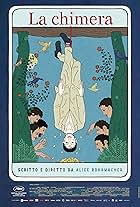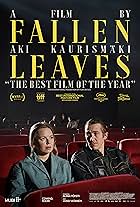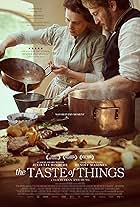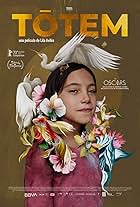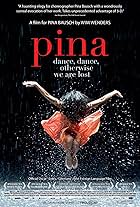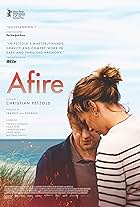IMDb RATING
7.2/10
1.8K
YOUR RATING
Anselm Kiefer is one of the greatest contemporary artists. His past and present diffuse the line between film and painting, thus giving a unique cinematic experience that dives deep into an ... Read allAnselm Kiefer is one of the greatest contemporary artists. His past and present diffuse the line between film and painting, thus giving a unique cinematic experience that dives deep into an artist's work and reveals his life path.Anselm Kiefer is one of the greatest contemporary artists. His past and present diffuse the line between film and painting, thus giving a unique cinematic experience that dives deep into an artist's work and reveals his life path.
- Awards
- 4 wins & 8 nominations
Ingeborg Bachmann
- Self
- (archive footage)
- (uncredited)
Joseph Beuys
- Self
- (archive footage)
- (uncredited)
Paul Celan
- Self
- (archive footage)
- (uncredited)
Martin Heidegger
- Self
- (archive footage)
- (uncredited)
- Director
- Writer
- All cast & crew
- Production, box office & more at IMDbPro
Storyline
Did you know
- TriviaAward: Lumière Award at the Lumière Film Festival in Lyon (2023).
- ConnectionsFeatured in Twist: Was soll von mir bleiben? Künstlerische Vermächtnisse (2023)
Featured review
"When a man puffs out his cheeks, he looks like God. When a man walks with a cross, he looks like Jesus."
This observation was expertly recorded by a writer Yerofeyev, but in his texts there is at least, if not self-irony, then mere irony. In Wim Wenders' film Anselm - Das Rauschen der Zeit, irony is not even present in the form of a hint. When the two mega-successful European maestros puff out their cheeks, the god-like quality reaches such an extent that you can only hold your breath for sheer pathos. That's how I said goodbye to two of my youthful idols in one evening.
More questions, of course, to Wenders, although basically I sympathize more with Kiefer as an artist. I would like to think that perhaps it was only a friend's camera, out of misunderstood friendly reverence, that failed to show him as a living human being, and indeed nothing human is alien to him. Wenders chisels the image of the artist out of marble and tries to show a block, a "hard man", and we get a stilted, lifeless figure.
Here Anselm thinks, here he lies figuratively with Celan's book, here he lies without Celan, stares thoughtfully into space, works, moves to an ever larger studio and stares meaningfully again. At some point, I stop distinguishing between the repetitive landscapes in the pictures and only see money, money, money. The 3D effect multiplies this money, we sit in the rain of money and look at the money.
The god-like male get-together is diluted by would-be gods: Kiefer's son and Wenders' nephew, who play the artist in his youth and childhood. The little boy contributes nothing but sentimentality and vulgarity. He stares meaningfully into space and makes no contact with anyone. Except to exchange a word with the only female character, the cleaning lady. Other women are only present in this masculine world, represented by an unreachable mother and symbolized by repeated white dresses with the same figure wearing either a haystack or a tuft of twigs instead of heads. Even old Freud would not be wrong here. Except for one minute, Ingeborg Bachmann flashed so vividly in this world of mannequins that this minute remained in my memory. Hard enough to refute the accusation of a lack of images of women, but also safe because it was short and long since dead and canonized.
I'm beginning to think that the lack of contact and self-absorption might be related to an autism spectrum disorder, and that this might be some kind of enlivening detail in the monotonous plot, a problem that takes the movie to another level. But we learn nothing about any disorders: The gods are disease-free, have no vices, are athletic and productive. Megaproductive. Not at all like Warhol's factory, because the production of guilt over National Socialism is serious business, not a laughing stock or, God forbid, drugs and freaks like Andy's. Kiefer's taciturn and equally wholesome and serious numerous assistants are beginning to remind me of the characters in a Lenny Riefenstahl film. A triumph of aesthetics. Does criticism take the form of the object to be criticized?
One cannot help but recall the words of Candice Breitz from the same article by Mascha Gessen, which, as expected, was not accepted in Germany: "Good intentions that emerged in the eighties too often become dogmas. Dogma and ossified form prevent us from seeing that nationalist ideas can flourish in a completely different form.
Is it possible to show an artist outside the system of criticism in today's world? Wenders created a mega-showreel, 6K, 3D, stereo sound, megalomaniac artist promo, a powerful spectacle, an attraction. He gave an almost tangible opportunity to see many works at once, something that would be impossible to see in an exhibition. And he didn't ask a single question.
As a teenager, Anselm Kiefer wrote in his diary that he wanted to become the most important artist in the world. It can be said that the patriarchal culture of heroes has given him this opportunity. Hero-winner Kiefer refuses to comment on his work. What is behind the artist's refusal? Could it be the realisation that the dragon winner himself is becoming a dragon?
Overwhelmed by the pathos, amazed by the beauty, unveiled by the aural, overwhelmed by the grandeur and covered in unexpected Christmas snow, I return to my emigrant home and only a long listen to Bomrani brings me back to my senses. I can't help it, I love this kind of music. Kiarash Omrani sings a migrant's song that says there is no hero and I want to go to a world without heroes.
Merry Christmas Eve and stay tuned )
This observation was expertly recorded by a writer Yerofeyev, but in his texts there is at least, if not self-irony, then mere irony. In Wim Wenders' film Anselm - Das Rauschen der Zeit, irony is not even present in the form of a hint. When the two mega-successful European maestros puff out their cheeks, the god-like quality reaches such an extent that you can only hold your breath for sheer pathos. That's how I said goodbye to two of my youthful idols in one evening.
More questions, of course, to Wenders, although basically I sympathize more with Kiefer as an artist. I would like to think that perhaps it was only a friend's camera, out of misunderstood friendly reverence, that failed to show him as a living human being, and indeed nothing human is alien to him. Wenders chisels the image of the artist out of marble and tries to show a block, a "hard man", and we get a stilted, lifeless figure.
Here Anselm thinks, here he lies figuratively with Celan's book, here he lies without Celan, stares thoughtfully into space, works, moves to an ever larger studio and stares meaningfully again. At some point, I stop distinguishing between the repetitive landscapes in the pictures and only see money, money, money. The 3D effect multiplies this money, we sit in the rain of money and look at the money.
The god-like male get-together is diluted by would-be gods: Kiefer's son and Wenders' nephew, who play the artist in his youth and childhood. The little boy contributes nothing but sentimentality and vulgarity. He stares meaningfully into space and makes no contact with anyone. Except to exchange a word with the only female character, the cleaning lady. Other women are only present in this masculine world, represented by an unreachable mother and symbolized by repeated white dresses with the same figure wearing either a haystack or a tuft of twigs instead of heads. Even old Freud would not be wrong here. Except for one minute, Ingeborg Bachmann flashed so vividly in this world of mannequins that this minute remained in my memory. Hard enough to refute the accusation of a lack of images of women, but also safe because it was short and long since dead and canonized.
I'm beginning to think that the lack of contact and self-absorption might be related to an autism spectrum disorder, and that this might be some kind of enlivening detail in the monotonous plot, a problem that takes the movie to another level. But we learn nothing about any disorders: The gods are disease-free, have no vices, are athletic and productive. Megaproductive. Not at all like Warhol's factory, because the production of guilt over National Socialism is serious business, not a laughing stock or, God forbid, drugs and freaks like Andy's. Kiefer's taciturn and equally wholesome and serious numerous assistants are beginning to remind me of the characters in a Lenny Riefenstahl film. A triumph of aesthetics. Does criticism take the form of the object to be criticized?
One cannot help but recall the words of Candice Breitz from the same article by Mascha Gessen, which, as expected, was not accepted in Germany: "Good intentions that emerged in the eighties too often become dogmas. Dogma and ossified form prevent us from seeing that nationalist ideas can flourish in a completely different form.
Is it possible to show an artist outside the system of criticism in today's world? Wenders created a mega-showreel, 6K, 3D, stereo sound, megalomaniac artist promo, a powerful spectacle, an attraction. He gave an almost tangible opportunity to see many works at once, something that would be impossible to see in an exhibition. And he didn't ask a single question.
As a teenager, Anselm Kiefer wrote in his diary that he wanted to become the most important artist in the world. It can be said that the patriarchal culture of heroes has given him this opportunity. Hero-winner Kiefer refuses to comment on his work. What is behind the artist's refusal? Could it be the realisation that the dragon winner himself is becoming a dragon?
Overwhelmed by the pathos, amazed by the beauty, unveiled by the aural, overwhelmed by the grandeur and covered in unexpected Christmas snow, I return to my emigrant home and only a long listen to Bomrani brings me back to my senses. I can't help it, I love this kind of music. Kiarash Omrani sings a migrant's song that says there is no hero and I want to go to a world without heroes.
Merry Christmas Eve and stay tuned )
- Paintedbird_Y
- Dec 29, 2023
- Permalink
- How long is Anselm?Powered by Alexa
Details
- Release date
- Country of origin
- Languages
- Also known as
- 安塞姆:廢墟詩篇
- Filming locations
- La Ribaute, Chemin de Ribotte, Barjac, Gard, France(The artist's gigantic workshop in the South of France)
- Production company
- See more company credits at IMDbPro
Box office
- Gross US & Canada
- $508,895
- Opening weekend US & Canada
- $56,241
- Dec 10, 2023
- Gross worldwide
- $1,829,884
- Runtime1 hour 33 minutes
- Color
- Aspect ratio
- 1.50 : 1
Contribute to this page
Suggest an edit or add missing content
















